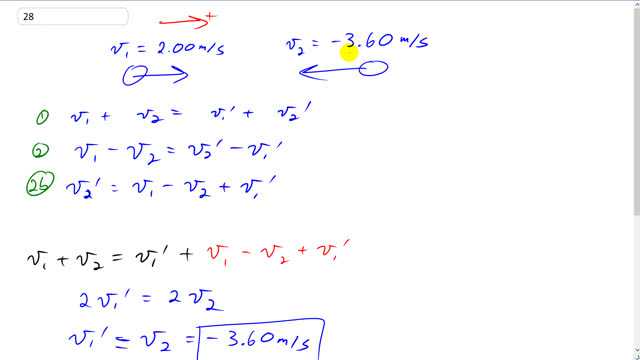
Two billiard balls of equal mass undergo a perfectly elastic head-on collision. If one ball’s initial speed was 2.00 m/s, and the other’s was 3.60 m/s in the opposite direction, what will be their speeds and directions after the collision?

In order to watch this solution you need to have a subscription.
This is Giancoli Answers with Mr. Dychko. So our picture is this where we have two billiard balls approaching each other; the first one has velocity of 2.0 meters per second and we'll say that's positive to the right and the other one has a velocity of negative 3.60 meters per second because we are told that it goes in the opposite direction and so if to the right is positive that means to the left is negative and so v 2 is negative 3.60. Here is the conservation of momentum formula but you don't see any m's anywhere because the masses are all the same m 1 I can just write as the letter m because there's no need to distinguish it from the m 2 since m 1 equals m 2 so it's just m, m, m, m written as a factor for each term but since it's a common factor everywhere, we can erase it, it cancels out when you divide both sides by m. And then this is the formula we have knowing that this is an elastic collision and so we can rearrange formula 2 and solve for v 2 prime and that will be useful because we'll rewrite equation 1 with v 2 prime eliminated by substituting this in its place in order to reduce the number of variables that we have only one unknown, v 1 prime here. So v 2 prime is v 1 minus v 2 plus v 1 prime when you add this to both sides and switching the sides around so we have the unknown v 2 prime on the left. So rewriting equation 1, version b, we have v 1 plus v 2 equals v 1 prime plus instead of v 2 prime, v 1 minus v 2 plus v 1 prime and this reduces nicely; we end up with two v 1 prime terms both having the same signs so that becomes 2v 1 prime and then we have this v 2 goes to the other side so it becomes this v 2 plus this v 2 and the v 1's disappear entirely because they have the same sign on opposite sides so anyway you can subtract v 1 from both sides and that makes them disappear. So we have 2v 1 prime equals 2v 2 and then divide both sides by 2 and you have that v 1 prime equals v 2. So what that means is when you have an elastic collision of two objects of equal mass, they will exchange velocities after the collision. So v 1 prime, the velocity of this object after the collision, will be equal to the velocity that this thing had before the collision. So v 1 prime is v 2. So v 1 prime is negative 3.60 meters per second and so after the collision, this object 1 will be moving to the left at 3.60. And v 2 prime is v 1 minus v 2 plus v 1 prime—as we know from this formula here— and we can now substitute for v 1 prime though and write v 2 there instead and well we have negative v 2 plus v 2 so that makes zero and so we see that v 2 prime equals v 1 so again we are seeing that it exchanges velocities. So v 2 prime becomes the velocity of the first object before the collision so velocity of the second object after the collision is the velocity of the first object before the collision; v 2 prime equals v 1 and it's gonna have velocity to the right of 2.00 meters per second. So the second object is going to rebound to the right at 2.00 meters per second after the collision.
no sound ;-(
Hi gellander97, thanks for the comment. The sound plays fine on this end, so just let me know if that happens again.
All the best,
Mr. Dychko
On this problem, the equation for elastic collisions is vA - vB = v'A - v'B, but why is the one on #25 negative for the final velocity (v') side?
Wait! Nevermind - got it.
but, that's not the answer. I'm working with a different problem, and in short, ball 1 v1=5m/s ball 2 v2=2m/s, and v1prime=-1.56 and v2prime=4.56m/s. What's going on? In my problem, the velocities don't just switch.
you are so helpful, finally i understand... thank you!!!